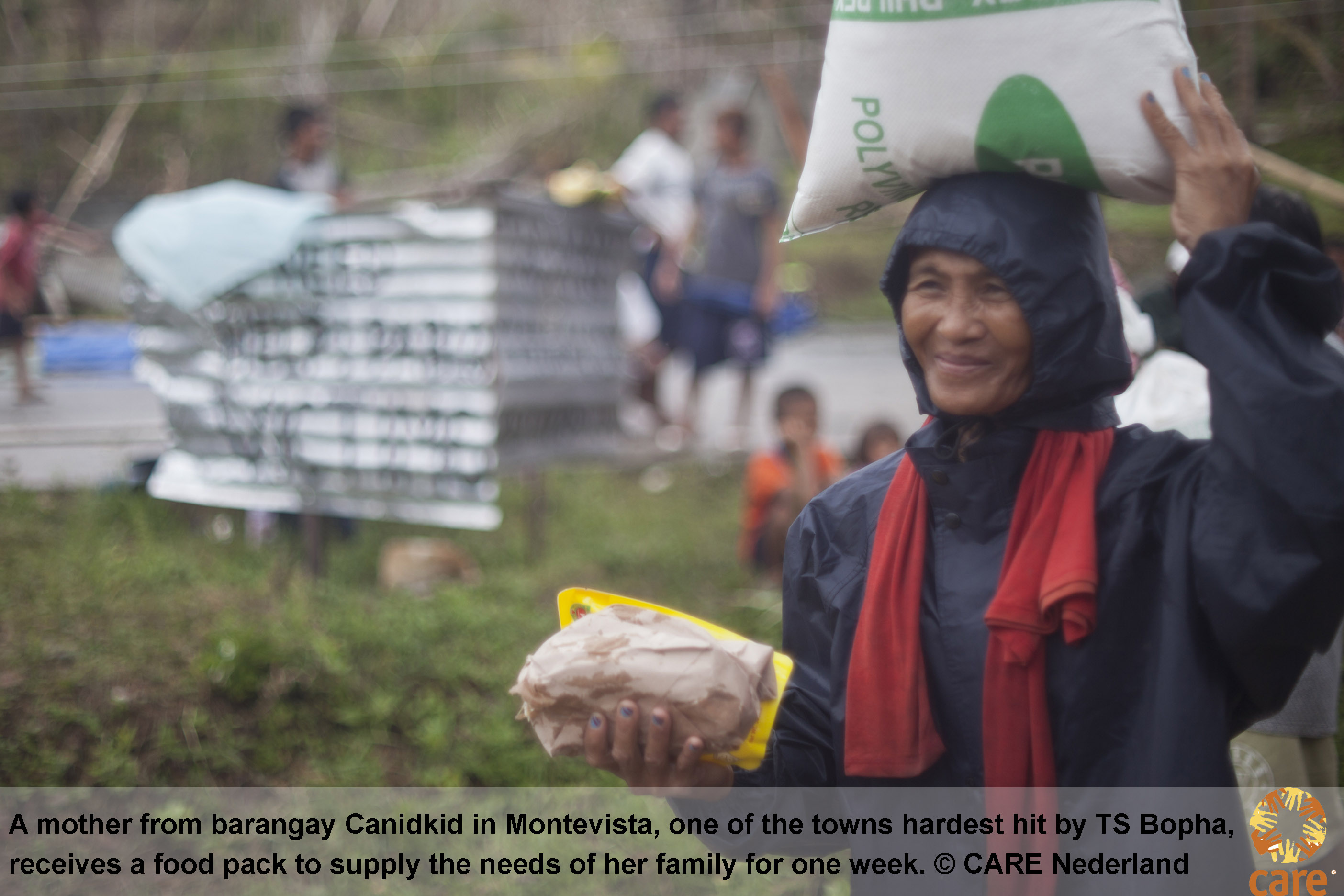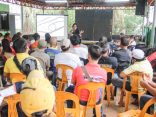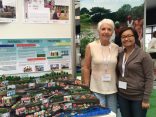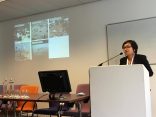 The women, consistent with their nurturing role in the family, worry about where to get food for the next meal. They also worry about their children getting sick because of poor shelter conditions, exposing children to the heat and cold, and to carriers of diseases such as mosquitos, and because of lack of clean water for drinking and other uses.
The women, consistent with their nurturing role in the family, worry about where to get food for the next meal. They also worry about their children getting sick because of poor shelter conditions, exposing children to the heat and cold, and to carriers of diseases such as mosquitos, and because of lack of clean water for drinking and other uses.
Interview with Celso Dulce, CARE Nederland’s Philippines representative and disaster risk reduction advisor
Cyclone Bopha has affected more than six million people. What are their greatest needs at the moment?
The affected people I spoke with said that their foremost needs are food and support for their livelihood recovery. Most of the affected people are engaged in smallholder farming of banana, coconut, oil palm and falcata trees, or as workers in big plantations. In between rows of coconut, smallholder farmers grow vegetables, mainly for household consumption. Cyclone Bopha, in the Philippines also called Pablo destroyed all these.
At present, people depend to a large extent for their nourishment on food relief. The most common food being consumed by affected populations are steamed rice, instant noodles and canned sardines. People are requesting the inclusion of vegetables in future food distribution.
The main crops being grown by the affected population would take time to recover – banana would take a year to become productive again; coconut or oil palm three years or more. The people recognize the need to immediately restart their livelihood recovery process, but need assistance, in the form of seeds, farm inputs and replacement of farm equipment and machinery lost to Pablo. Considering the local seasonal calendar for agriculture, livelihood recovery support should be provided not later than January 2013. Failing to do so would lengthen the duration of food shortage among affected populations by at least three months.
Are women and girls particularly affected? If so, what are their greatest needs?
The women, consistent with their nurturing role in the family, worry about where to get food for the next meal. They also worry about their children getting sick because of poor shelter conditions, exposing children to the heat and cold, and to carriers of diseases such as mosquitos, and because of lack of clean water for drinking and other uses. They worry that their community health center is not functioning anymore, and that they have no access to medicine and health services.
Children, boys and girls alike, are unable to attend school because the school buildings are damaged. Young boys and girls won’t be able to continue attending school due to lost household incomes.
How are CARE and its partner organizations responding?
CARE and its partners are collaborating with five other international organizations (INGO) to fill the gaps in the needs of the most vulnerable households in most affected areas. The INGO consortium is providing comprehensive assistance consisting of food, shelter and essential relief items, water, sanitation and hygiene as well as health support. CARE and partners have targeted upland areas, often populated by indigenous peoples, that are difficult to access and therefore receiving less assistance, if at all.
Targeted beneficiaries, and women in particular, are involved in planning and distribution of assistance. Disaster risk reduction is also incorporated in the response, by providing information on hazards and how individuals, families and communities can prepare for future hazards and reduce risks. Information is provided to households rebuilding their houses on how to incorporate basic risk reduction measures such as selecting proper location and improving construction practices.
Is there enough funding available from the international community to fund the humanitarian response in the Philippines?
The Philippine government has appealed for international assistance and the UN system on December 10, 2012 and has responded by issuing a US$ 65 million appeal to be able to provide immediate lifesaving aid and support to recovery of 480,000 people. There is no information yet on how much has been raised already from this appeal. The announced commitments of government and aid agencies total US$ 20,256,000; the Philippine government has so far spent US$ 4.5 million, and a private telethon has reportedly raised US$ 2.4 million. There is not enough funding available from the international community, and even including local resources.
Is there a high risk of an outbreak of diseases?
There is already a reported diarrhea outbreak in Cateel municipality in Davao Oriental. Tests conducted revealed that there is high level of contamination of water sources in the area. Mothers report of their children getting sick with fever and common colds, attributed to their exposure to the heat and the rain. In the most affected areas, almost all houses have sustained damage and therefore provide inadequate shelter to family members.
Cyclones are recurring every year in the Philippines. How can people better protect themselves from such a natural force?
The areas affected by Bopha were seldom visited by typhoons in the past. A combination of lack of awareness and preparedness amongst communities and local authorities, unsustainable agriculture practices, and environmental degradation has resulted in this disaster. On the other hand, in locations where CARE has been implementing community-based disaster preparedness that incorporates climate change adaptation and ecosystem management and restoration, communities and local authorities have demonstrated that losses and suffering from disaster can indeed be significantly reduced.
Saint Bernard municipality in Southern Leyte, and communities in Agusan del Sur, Bukidnon and Iligan City have demonstrated that people can better protect themselves by being aware of local risks, and having basic knowledge on what to do prior to, during and after a hazard event. Communities working together with local authorities can develop community contingency plans including early warning systems and evacuation plans, which can be activated in the event of a hazard.




